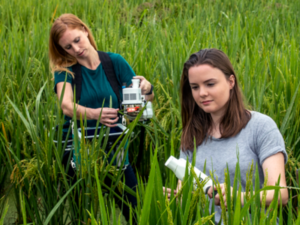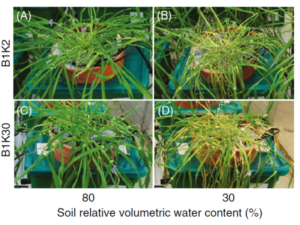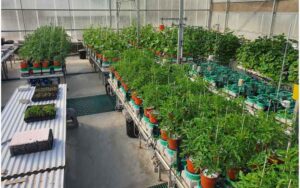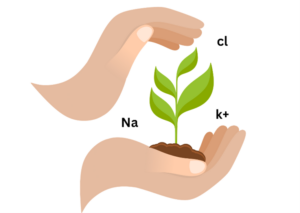As global challenges like food security, climate change, and resource conservation continue to grow, plant screening systems have become indispensable tools in agriculture and plant research. These systems facilitate the identification of high-performing plant genotypes, enabling researchers and breeders to optimize crops for better yield, stress resistance, and resource efficiency. Modern plant screening systems integrate advanced technologies, such as real-time sensors, automated data collection, and predictive analytics, to streamline the evaluation of plant traits.
A plant screening system is a combination of hardware and software designed to evaluate plant traits under controlled or semi-controlled environmental conditions. These systems measure various physiological and morphological parameters, such as transpiration rate, water-use efficiency, photosynthesis, biomass accumulation, and root growth. By providing precise, high-throughput data, they allow researchers to correlate plant performance with specific genetic traits and environmental conditions.
The ability to screen plants at scale is crucial for:
- Developing stress-tolerant and high-yield crops.
- Understanding plant responses to environmental variables.
- Accelerating breeding programs by identifying promising genotypes early.
- The Role of Advanced Plant Screening Systems in Modern Agriculture
One of the innovations in this field is our PlantArray system, which has redefined how researchers monitor and analyze plant-environment interactions.
What are the applications in Research and Agriculture?
Plant screening systems are used in diverse applications, including:
Phenotyping Studies: Understanding how genetic traits influence observable characteristics.
Sustainable Agriculture: Developing crops that require fewer resources, reducing environmental impact.
Breeding Programs: one of the most common applications is to elect genotypes with desirable traits like drought tolerance or nutrient efficiency.
Plant Genetic Screening System
Plant genetic screening has emerged as a cornerstone of modern plant research in the quest for sustainable agriculture and improved crop performance. By analyzing genetic traits and their interactions with environmental conditions, researchers can identify high-performing plant genotypes, optimize crop yields, and improve resilience to drought, salinity, and temperature fluctuations. In this blog, we will focus on the PlantArray system, a cutting-edge solution that integrates advanced monitoring and data analysis to streamline the plant genetic screening process.
What is Plant Genetic Screening?
Plant genetic screening involves analyzing the genetic makeup of plants to identify traits associated with performance, resilience, and productivity. This process is vital for breeding programs to create plants that can withstand environmental challenges while maintaining high yields.
Key components of plant genetic screening include:
- Genetic Analysis: Studying specific genes linked to desirable traits.
- Environmental Simulation: Monitoring plant responses to controlled environmental conditions.
- Data Integration: Using advanced software and platforms to process complex datasets.
Traditional methods of plant genetic screening often fall short of capturing the dynamic interaction between plant reactions to environmental stresses. However, the integration of advanced technologies, such as PlantArray, has bridged this gap, offering real-time insights into plant performance under a variety of stress conditions.
The Role of Plant Genetic Screening Platforms
A plant genetic screening platform combines hardware and software solutions to conduct large-scale, precise evaluations of plant traits. Such platforms enable researchers to:
- Testing multiple genotypes under different conditions.
- Simulate diverse environmental stresses, such as drought, salinity, or nutrient deficiencies
- Automate data collection and analysis for efficiency and accuracy.
The PlantArray system serves as an exemplary plant genetic screening platform. Designed to analyse plant-water relations and growth dynamics, PlantArray integrates advanced sensing technologies with user-friendly software to deliver unparalleled precision. By continuously monitoring parameters such as stomatal conductance, transpiration, and plant biomass accumulation, PlantArray provides a comprehensive picture of plant performance.
Plant Genetic Screening Models: Testing plants’ behavior under various environmental conditions is essential to try to predict yield potential. Developing genetic screening models is also essential to this. These models combine genetic data with physiological measurements to simulate how plants might perform in specific scenarios.
The PlantArray system contributes to the development of these kinds of models by providing high-resolution data on plant-environment interactions. For example, its ability to measure plant water-use efficiency under different irrigation regimes enables researchers to create models that predict performance under drought stress.
Why Development of genetic models are important?
- Designing breeding programs focused on specific traits.
- Optimizing agricultural practices for different crops and regions.
- Reducing the trial-and-error approach in plant selection.
How PlantArray Supports Advanced Genetic Screening?
- High Throughput: PlantArray enables simultaneous monitoring of multiple plants, making it ideal for large-scale screening experiments.
- Precision Monitoring: Advanced lysimeter in combination with Sensors that tracks and captures key growth parameters with unparalleled accuracy, ensuring reliable data.
- Customizable Conditions: The system measures under different environmental conditions, such as humidity, salinity, and temperature, to mimic real-world stress conditions according to the researcher’s research.
- Remote Management: PlantArray supports remote monitoring, ensuring uninterrupted data collection.
Real-World Applications of Plant Genetic Screening
Plant genetic screening has applications in various fields, including:
- Crop Breeding: Identifying genotypes with superior traits for drought resistance, high yield, or nutrient efficiency.
- Stress Tolerance Research: Understanding how plants respond to extreme environmental conditions.
- Sustainable Agriculture: Developing crops that require fewer resources while maintaining productivity.
For instance, researchers using the PlantArray system have successfully screened for drought-tolerant genotypes in wheat, significantly advancing breeding efforts. By monitoring water uptake and transpiration dynamics, the system provided critical data that informed the selection of high-performing varieties.

The PlantArray system used in the current study. (A) Top view of the automated physiological phenotyping array with 100 measuring units loaded with cowpea seedlings. (B) Illustration of the θcri and KTr in four representative accessions.
Xinyi Wu et. al., (2021), Front. Genet. DOI: 10.3389/fgene.2021.743758
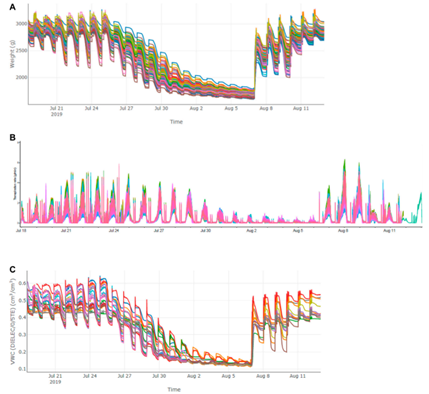
Variations of different parameters in the population in Trial 2 during the course of the experiment. (A) system weight; (B) transpiration rate; (C) VWC.
Xinyi Wu et. al., (2021), Front. Genet. DOI: 10.3389/fgene.2021.743758
Plant genetic screening is a transformative field with the potential to address some of the most pressing challenges in agriculture. By integrating advanced platform, and software, researchers can unlock new insights into plant performance and resilience. The PlantArray system, with its precision monitoring, customizable conditions, and software, stands as a cornerstone of this innovation.
Whether you’re developing genetic screening models, conducting large-scale experiments, or exploring the potential of some genotypes, the PlantArray system is an indispensable tool.

